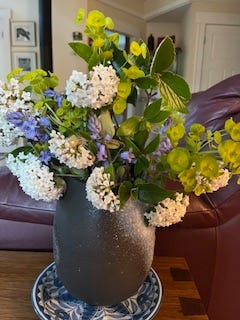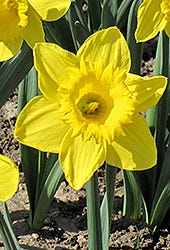When there are holes in our family history, it’s human nature to weave stories that explain them. How accurate are our reconstructions? We may treat them like facts, but let’s face it, they’re guesses.
Humans are hardwired to want patterns. We ask questions and speculate because patterns give us pleasure, and we feel safer, like we’re more in control when we can make sense of things. We want to force this chaotic, puzzling world into stories that make sense. Think of the thousands of years humans have gathered in family groupings around a fire and shared tales of bravery and daring. We pick out shiny bits of narrative, hold them up to the light and marvel.
It wasn’t until after my parents had died that I started asking questions about their pasts I’d never get answers for.
Earlier this year, I found myself out in my garden on Pender Island, cutting flowering viburnums, grape hyacinths, early bluebells and some Corsican bush mint and Sarcococca for greenery. And once again, I asked myself: where did my father learn to arrange flowers? His skill was magical. Dad didn’t use flowers from gardens. He collected wildflowers and self-sown blooms along the back laneways where we lived, interestingly shaped weeds, sedges, maybe a fallen branch, certainly bulrushes, though these came from elsewhere. His approach was spare and Japanese. What he put together was gorgeous, like something from a high-end florist. How did he learn to do this?
Recently my brother found our dad’s service records. Our grandfather was writing to thank a Colonel for his courtesy in sending his fifteen-and-a-half-year-old son home. It was the Second World War and our father was trying to enlist. When he was sixteen, he was accepted as fit for military service and sent overseas as an anti-aircraft gunner. After Dad survived the war, he got a Master’s degree in Art History, finishing with postgraduate studies at the Slade in London.
It doesn’t seem realistic to think Dad acquired his skill in flower arranging from studying Old Masters’ paintings. He even owned what are called flower frogs, spiky metal affairs that you place in a container. When you press the flower stem in, it stays. These were not common household accessories in a middle-class Canadian home in the 1960s. Dad bought them in a Japanese store on Powell Street in Vancouver.
I asked my sister, “Where did Dad learn how to arrange flowers?”
“His mother,” my sister said. “She was English. She knew about flowers. I hope not, mm, you know.” I did know. We don’t dignify this person with a name. The shorthand of families.
“Maybe,” I said. “His dad was the gardener, but he grew vegetables, not flowers. You’re right, Minnie would’ve done the flowers.” Minnie was our grandmother.
“Dad forced bulbs when we were growing up,” my sister said. “Remember?”
When she said that, I had a sudden visual memory of the coal cellar of our old house in Ottawa where Dad used to force paperwhites, hyacinths and daffodils. He used to grow about seven pots of each that he’d bring out in sequence during a long winter. He showed me how to do it. I even remember that King Alfreds were his favourite variety of daffodil; he showed me at a garden store how to pick the best bulbs.
I asked my brother, “Where did Dad learn how to arrange flowers?”
My polite, kind brother growled. Literally. Ahh, the same name my sister didn’t want to speak: the woman Dad left our family for.
“But Dad arranged flowers long before he met her,” I said.
“That’s true,” my brother said. I could hear the hope in his voice.
“I was wondering if he was influenced by Bishop Sakimoto,” I said. My brother and I got into a long and happy discussion about Bishop Sakimoto, who accompanied an important exhibit of fine art from Japan in the early1960s. Dad had arranged this exhibit at the National Gallery of Canada, where he was then Assistant Curator. As well, he had the happy task of shepherding Bishop Sakimoto around Ottawa as a tour guide and cultural interpreter. Travel between Japan and Canada was much less frequent at that point than it is now, and many Western customs offended the good Bishop. A steak on a plate, for example: “Do they think I am a dog that they give me meat that is not cut up?”
Dad and Bishop Sakimoto also discussed flower arranging.
I tell myself that our father didn’t learn flower arranging from the woman he left our family for. She took classes in it. That came later, I say. Much later than the bulb-forcing in Ottawa, and when Dad and I wandered the laneways by our Vancouver house to collect plant material. When we got home, he’d take one vase, give me another, and then critique my arrangement as we went along. “Start with the greenery. You want the structural elements in first. Cut that one shorter; you want the heights to be different. Now, walk around and look at it from all sides. You don’t want to make your arrangement flat so it looks good from one angle. All right, what are you going to put in next? Maybe save that flower until the last; it’s delicate and you want to display it properly.”
So what’s true? It’s obvious what’s going to make our family legend a sparklier affair. Oh yes, our father learned flower arranging from his mother who was quite the flower gardener. Later in life, his approach was refined by contact with an esteemed Japanese art historian, one Bishop Sakimoto. This is a good story to tell around a fire with a glass of wine.
Family history? Family fiction?
I’m sticking with the version that involves the Bishop, thanks.










This is true about weaving being an art itself. It's an interesting challenge to try to approach a hole in the narrative in a spirit of genuine enquiry.
The weaving is an art in itself.